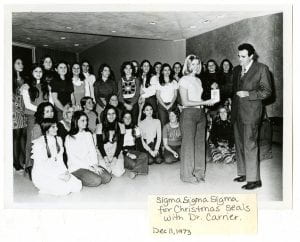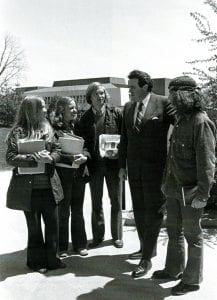Post Author: Amanda Castellano

Student life radically changed after Dr. Carrier became president of Madison College. Old dorm restrictions were done away with and students were allowed more freedom to make their own choices. When other colleges had stopped building dormitories to provide to their students, Madison was offering new dorms to students almost every year in the 1970’s. Students started to become more involved with the administration of the campus and the Student Government Association became invested with new responsibilities. By 1974, the individual deans for women and men were gotten rid of and replaced with a dean of students, directors of student life and health services were appointed, and everything administratively that involved students was placed under the new Department of Student Affairs (Robertson, 264-265).
Carrier also maintained a personal relationship with his students. In his interview on April 2nd, 2013, Dr. Carrier remembered visiting every dorm on campus at least once a semester, cooking in the dining halls, mcing the local radio station, and inviting students to eat with him and Mrs. Carrier at Hillcrest House. He came to be known affectionately as “Uncle Ron” and Carrier attributed this nickname to the fact that young people are more likely to get along with their uncle than their parents and that their uncle will let them get away with things (Interview, April 2nd, 2013). Carrier’s overarching philosophy about students was that they were consumers and that it was the administration’s job to provide them with what they needed and services that would make their experience at Madison more enjoyable.

Dr. Carrier also wanted to diversify the student population in terms of its race, gender, and social background. Carrier knew that higher education was important for improving the social standing of students, especially minority students and that, “if the problems of minority youth are to be solved in America, colleges and universities must provide a way for these youngsters to have social mobility” (Need for Diversity). Madison started offering new services to help improve the experience of these students. Daphyne Thomas in an interview on March 26th, 2013 recalled that Madison College was the only school in Virginia that was popular among African-Americans due to the services it provided to minority students. She recalled such things as Step Shows, sororities and fraternities, and academic resources that were provided to African-Americans that kept them involved in Madison and helped place them on the path to academic success.

Another big issue encountered during the 1970’s was the quick enrollment increases that occurred in the early years of the Carrier presidency. In 1970, the total enrollment at Madison College was 4,041 students while only 24.54% of those students were men. By 1975, Madison had already reached its goal of having 7,000 students enrolled by 1980 with 7,343 students enrolled, 41.02% of whom were male. These enrollment figures would stay consistent throughout the rest of the decade until university status could be achieved and more money was provided to the college. Madison had undergone a rapid transformation in just 5 years and student services became strained and unable to handle this new influx of students. Dorms became overcrowded and parking lots became nightmares. However, Carrier knew that in order to expand the academic curriculum, offer new services, and justify the change to university status, enrollment needed to increase dramatically. It is evident that the strategies of Carrier and his administration to increase enrollment worked efficiently because they achieved their goal of reaching 7,000 total enrollment in half the time that was expected.
With this new influx of students, however, there was a fear by some faculty members that Carrier was sacrificing academic standards. Dr. Sidney Bland in an interview on March 22nd, 2013 recalled that there was a general feeling among the faculty that Carrier was lowering the academic standards to allow more men in and that SAT scores were dropping. Daphyne Thomas in her interview also stated that some faculty felt that the students were being placed at a higher priority at the expense of the faculty and academics. Median SAT scores did drop from 1971-1974, but only by around 30 points and had reached 1,000 points by 1976 (Robertson, 249). In 1970, the percentage of students in the first quartile of their high school class was 58.77% and this figure dropped to 47.51% by 1973. However, when the school started measuring the percentage of students in the top three deciles of their high school class, a shift from 25% to 30%, the statistic was 72.01% in 1974 and had reached 83.96% by 1977 (Robertson, 248). By analyzing these statistics, it is apparent that academic standards were not sacrificed in order to increase enrollment and that they had greatly improved by the end of the 1970’s.
The evolution of the student body was extremely important in changing the philosophy of Madison College and justifying the eventual change to university status.
Works Cited
Bland, Sidney. Interview by Amanda Castellano. Personal Interview. Harrisonburg, VA. March 22nd 2013.
Carrier, Ronald E. Interview by Amanda Castellano. Personal interview. Harrisonburg, VA, April 2nd 2013.
Robertson, Emily. “The Transformation of Madison College into James Madison University: A Case Study.” Doctoral dissertation, College of William and Mary, 1991.
Thomas, Daphyne. Interview by Amanda Castellano. Personal Interview. Harrisonburg, VA. March 26th, 2013.
